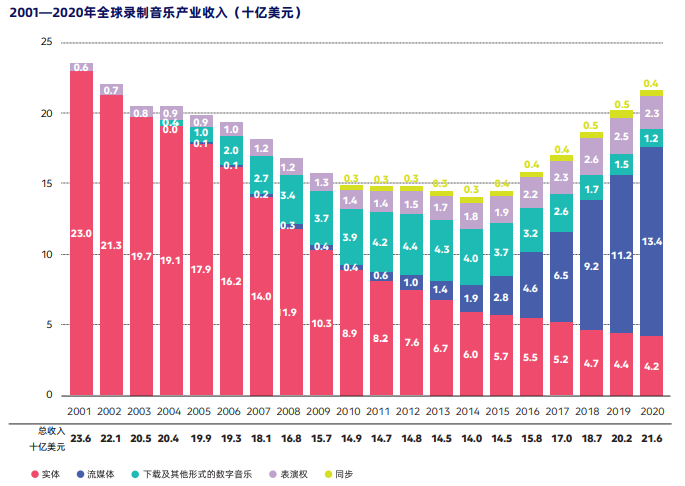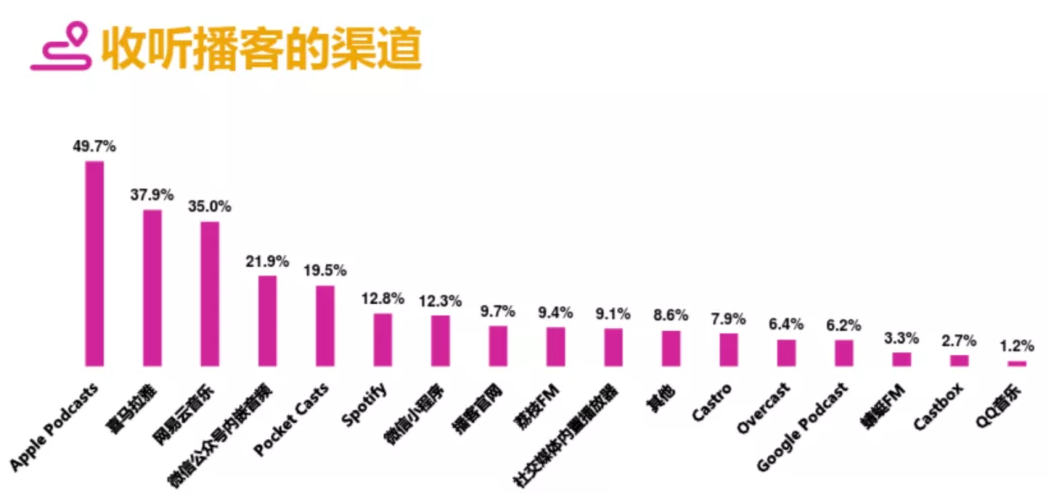Income. Needless to say, the domestic Tencent Music’s not-so-obtrusive pay rate. Even Spotify, whose pay income is the main revenue, is still at a loss. In short, the streaming media are basically giving the three major players. Record part-time job.
According to the “2021 Global Music Report” released by IFPI (International Association of the Phonographic Industry) not long ago, although physical music revenue fell 4.7% last year, and due to the epidemic, live performance revenue fell 10.1%, but streaming media revenue increased It offsets the decline in revenue from other formats. The total revenue of streaming music (including paid subscriptions and advertising support) increased by 19.9% to $13.4 billion, accounting for 62.1% of the total revenue from recorded music worldwide.
“2021 Global Music Report”
China is still the seventh largest music market in the world, second only to Japan and South Korea in Asia. Among them, music fans use streaming media to play music is the main driving force of this growth, especially the revenue growth of subscription streaming media is the most obvious, reaching 18.5%. As of the end of 2020, the number of paid subscribers reached 443 million.
It was also thanks to the strong pull of streaming media revenue that the financial data of the three record companies was still very impressive last year.
The third quarter financial report of Universal Music Group (UMG) showed that its streaming media revenue reached 992 million euros, an increase of 22.6% over the same period last year; digital download revenue was 86 million euros, a year-on-year decrease of 17.9%; music copyright agency revenue was 303 million euros, an increase of 6.2% year-on-year. Even under the new crown epidemic, physical record sales continued to grow, reaching 256 million euros.
Warner Music Group’s fourth fiscal quarter report shows that in the three months ending September 2020, its total revenue was $1.126 billion. Among them, recorded music revenue was US$958 million, a year-on-year increase of 0.52%; music copyright agency revenue was US$169 million. Streaming media revenue increased by 16.2% year-on-year to $639 million, accounting for 66.7% of the overall recorded music revenue and 56.7% of the total revenue. The growth of digital income and the decline of physical income reflect the continuous shift of music listening channels to streaming media. Streaming media has become the company’s largest and fastest-growing source of income.
In the fiscal quarter ending September 30, 2020, Sony Music’s revenue exceeded US$2.21 billion, a year-on-year increaseAbout 111 million U.S. dollars. In addition to the music copyright agency business, recorded music business and visual media platform revenue both increased significantly during the quarter. Among them, the revenue from streaming media in the recorded music business increased by 152.8 million U.S. dollars over the same period in 2019, a total of about 760 million U.S. dollars; Sony’s music visual media platform (including music and visual product services) revenue increased by about 13.44 million U.S. dollars.
Even in 2020, under the shadow of the epidemic, the two major record companies among the Big Three have decisively chosen to accelerate their entry into the capital market.
In the first half of 2020, Warner Music returned to the long-lost capital market. This was its re-listing nearly ten years after its privatization and delisting in 2011. The US$1.925 billion financing scale also became the largest IPO of US stocks in the first half of 2020. Vivendi, the parent company of Universal Music, has also confirmed that Universal Music will be split up and listed in 2022, which is one year earlier than the previously officially announced IPO time.
Warner Music’s debut on the Nasdaq display screen
It can be said that from resisting to actively embracing streaming media, the three major record companies have been able to survive the epidemic of the century last year. After all, in addition to watching dramas and playing games, most content consumers are still trapped in listening to music for several months. The best choice when at home.
Nowadays, people have long been accustomed to the life of just opening an app and listening to a large number of songs. Records are still sold, but they are no longer the main source of income for record companies.
For music streaming media platforms, the initiative is really not in their hands. Unlike the decentralized copyright of film and television content, music copyright is almost a highly concentrated monopoly market. It has gone through a long period of development. Now people Almost all the copyrights of well-known golden songs and golden songs are in the hands of major record companies.
In this situation, even if it is not a wild price, it is difficult to say that buyers and sellers are equal. After all, there are so many streaming media platforms, and there is always only a small part of music that allows users to really spend money.
However, this kind of “lying to win” has also caused dissatisfaction on various platforms, just as music streaming itself is a reform of the way of listening to music, as several giant platforms begin to move from staking to fine In fact, the battle with record companies has just begun.
Pay as you need and recommend human flesh, streaming media will not sit still
Compared with the simplicity and clarity of film and television copyright, users can watch it after the platform buys it. Music copyright is much more complicated.
The copyright of a musical work usually includes two parts: the copyright of the recording and the copyright of the song and music.
The popular name of recording copyright is “music mastering.” In the past, it may be physical recording files such as tapes, CDs, etc. These are the actual complete works recorded in the studio as singers that users can hear. Generally speaking The “exclusive” emphasized by streaming media platforms also usually refers to the copyright of recordings; copyrights of lyrics and music are often related to cover songs and various re-creations. For example, if you only own the copyright of David Bowie’s lyrics and music, it means those music on the platform. The creator can use his lyrics and music to sing, but ordinary users still cannot hear the original version of David Bowie.
Therefore, it corresponds to the pricing and settlement system directly linked to money. It is also very complicated. The music industry has a set of detailed copyright pricing rules. The prices of songs on-demand copyright, soundtrack copyright, and download copyright are all different.
This is why platforms with limited resources can only choose to do the so-called “XX FM”. Users cannot choose to listen to a song repeatedly, because the radio-based on-demand copyright is much cheaper.
For large companies, the music copyright in the general sense is a buy-out system, and money is paid to buy the copyrighted music library of the record company in batches as the main selling point to attract users. Of course, just as there are only two to three golden songs for an album, the so-called “massive” music library provided by various record companies, in fact, the real hits can only account for at most 20 to 30%, and a large amount of music is packaged in. People or songs are actually types that no one cares about. But this is precisely where the record company is shrewd, after all, similar business models have been successful for too long.
As the music streaming media platform becomes bigger and stronger, this somewhat similar model of strong buying and selling is also changing in the game between the two parties.
Some international music platforms such as Spotify, YouTube, Apple, Amazon and other companies have begun to try to pay royalties based on the actual playback volume of a single song. For example, Spotify is priced at $0.00331/time, YouTube Music is priced at $0.0054/time, and Apple Music is priced. US$0.00495/time, Amazon Music is priced at US$0.00395/time.
Under this model, the past classic tracks and the constantly emerging hits will still make the record company a lot of money, but the platform can at least ensure that the interests of niche music lovers are taken into account. It can also reduce cost pressures to a certain extent.
At the same time, now major music streaming media platforms have begun to focus on original content-creating original podcast brands, one entertainment observation (ID: yiyuguancha) is inThe logic of “Podcasts 2021: From “Roadside Stalls” to Giants “Dish Chinese Food”” has been discussed in detail. Podcast content is the biggest original sign for today’s music streaming platform, which can effectively control the entire creation. At the same time, the chain can hold the copyright for a long time. From Spotify to Apple to the domestic Tencent Music and NetEase Cloud Music, almost all take podcasting as the next point of force.
“PodFest China 2020 Chinese Podcast Listener and Consumption Survey”
Of course, music is still the center of original audio content. In the case where several major record companies have almost monopolized well-known creators, platform companies are more focused on independent musicians.
The two short video platforms of its two major short video platforms also need the bytebeat of music. In January 2019, they launched the “Seeing Music Project” (a purpose of mining and supporting independent musicians). In July of the same year, they acquired British Music Artificial Intelligence. Start-up company Jukedeck. All major platforms are striving to create their own golden songs while maintaining copyright ownership as much as possible, even though this road has not yet had too many successful cases.
For more music that may not be created by record companies in the future, what the streaming platform actually needs to be strengthened is not the “smart recommendation algorithm” that is now vigorously promoted. On the contrary, it should actually choose the real People who understand music and have a certain taste in music come to “human flesh recommendation” these new music and musicians.
For a long time, data-driven technology companies have always looked at the traditional practices of record companies and musicians with contempt, but in fact, a book “How Music Got Free” was born in the same year as Apple Music. It tells how traditional musicians use data to think, and at the same time reveals the importance of content recommendation.
In the 1960s, when sales data were far less readily available than today, Doug Morris, who worked at the record company Laurie Records, noticed that a record store in Cumberland, a small city in Maryland, had purchased a large number of records called “Little Bit O’Soul.” . Everyone didn’t pay attention to this detail, but Morris asked his colleague in the purchasing department to call the record store and asked the owner of the reason. It turned out that a local DJ was on the phone


